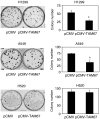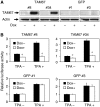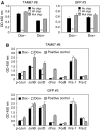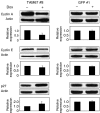Growth inhibition of non-small cell lung cancer cells by AP-1 blockade using a cJun dominant-negative mutant
- PMID: 18283312
- PMCID: PMC2266861
- DOI: 10.1038/sj.bjc.6604267
Growth inhibition of non-small cell lung cancer cells by AP-1 blockade using a cJun dominant-negative mutant
Abstract
cJun, a major constituent of AP-1 transcription factor transducing multiple mitogen growth signals, is frequently overexpressed in non-small cell lung cancers (NSCLCs). The purpose of this study is to determine the effects of AP-1 blockade on the growth of NSCLC cells using a cJun dominant-negative mutant, TAM67. Transiently transfected TAM67 inhibited AP-1 transcriptional activity in NSCLC cell lines, NCI-H1299 (H1299), A549 and NCI-H520 (H520). The colony-forming efficiency of H1299 and A549 was reduced by TAM67, while that of H520 was not. To elucidate the effects of TAM67 on the growth of H1299, we established H1299 clone cells that expressed TAM67 under the control of a doxycycline-inducible promoter. In the H1299 clone cells, the induced TAM67 inhibited anchorage-dependent growth by promoting G1 cell-cycle block, but not by apoptosis. The induced TAM67 decreased the expression of a cell-cycle regulatory protein, cyclin A. TAM67 also inhibited anchorage-independent growth of these cells. Furthermore, TAM67 reduced growth of established xenograft tumours from these cells in nude mice. These results suggest that AP-1 plays an essential role in the growth of at least some of NSCLC cells.
Figures








References
-
- Angel P, Allegretto EA, Okino ST, Hattori K, Boyle WJ, Hunter T, Karin M (1988) Oncogene jun encodes a sequence-specific trans-activator similar to AP-1. Nature 332: 166–171 - PubMed
-
- Angel P, Imagawa M, Chiu R, Stein B, Imbra RJ, Rahmsdorf HJ, Jonat C, Herrlich P, Karin M (1987) Phorbol ester-inducible genes contain a common cis element recognized by a TPA-modulated trans-acting factor. Cell 49: 729–739 - PubMed
-
- Bohmann D, Bos TJ, Admon A, Nishimura T, Vogt PK, Tjian R (1987) Human proto-oncogene c-jun encodes a DNA binding protein with structural and functional properties of transcription factor AP-1. Science 238: 1386–1392 - PubMed
-
- Brown PH, Chen TK, Birrer MJ (1994) Mechanism of action of a dominant-negative mutant of c-Jun. Oncogene 9: 791–799 - PubMed
-
- Curran T, Franza Jr BR (1988) Fos and Jun: the AP-1 connection. Cell 55: 395–397 - PubMed
Publication types
MeSH terms
Substances
LinkOut - more resources
Full Text Sources
Medical

